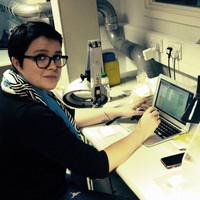Affiliation: University of North Carolina at Greensboro

Dr. Claire Heckel is the Project Coordinator of the People Not Property Project at the University of North Carolina, and previously was a Post-Doctoral Researcher at the American Museum of Natural History. She holds her degrees from New York University (Ph.D. and M.A.) and Randolph-Macon Woman’s College, and her research is focused on art and personal adornment in prehistory, the use of mammoth ivory, and archaeological science in the study of prehistoric art. Her recent publications include “Reconsidering production organization in the Early Upper Paleolithic: the case for specialized production of Aurignacian beads’ in Quaternary International 491, 2018.
Female figurines are among the most enigmatic and alluring art objects from the Palaeolithic period. Over the 120 years that have followed their discovery, this diverse body of objects has been subjected to a several phases of interpretation, each of which has arguably reflected the cultural preoccupations of the modern viewer more than the intentions of the prehistoric artist. At the time of their discovery in the late 19th Century, sexuality and fertility went virtually ignored, eclipsed by evolutionist concerns with the racial hierarchies. Randall White has demonstrated that the term “Venus figurine” is a direct reference to the “Hottentot Venus” Sartje Baartman and reflects the primitivist attitudes toward both Palaeolithic people and contemporary hunter-gatherers that were dominant in the 1890s. More recently, with the discovery of the “Hohle Fels Venus” in Germany in 2009, news headlines reflected an entirely different cultural preoccupation, branding the newfound figurine a “Palaeolithic Pin-up” and “Paleo Porn.” April Nowell and Melanie Chang dismantled this interpretation in a 2014 paper, revealing it to be another reflection of current cultural preoccupations and a suite of erroneous assumptions about both the figurines and gender and sexuality in prehistory. This lecture traces the twentieth-century origins of the “Fertility Figurine,” one of the most widespread and enduring interpretations of Palaeolithic images of women. Drawing on primary sources from the era, it identifies the precise cultural moment when the interpretive gaze shifted from race to gender in the years following the First World War. As anxieties about gender roles and birth rates reached the level of obsession in Interwar France, these ancient objects were drawn into discussions of women’s “natural and eternal” obligations. Understanding prehistoric works of art requires an understanding of both Paleolithic contexts of production and the historical roots of various frameworks of interpretation, and this lecture aims to provide the audience with a detailed overview of both.
Short bibliography and/or website on lecture topic:
White, R. 2006. The Women of Brassempouy: A Century of Research and Interpretation. Journal of Archaeological Method and Theory 13(4): 251–304.
Nowell, A and M. Chang. 2014. Science, the Media, and Interpretations of Upper Palaeolithic Female Figurines. American Anthropologist 116(3): 562-577.
Once thought to have emerged in a sudden, “Big Bang” moment of cultural evolution, the origins of symbolic material culture are now understood to be complex and mosaic, emerging and intensifying under specific conditions and various moments over our species’ long evolutionary history. One of these moments of intensified artistic production is the Aurignacian period of Palaeolithic France, as early Homo sapiens populations established themselves on the landscape, eventually to the demise of our Neanderthal cousins. Touching on major debates in prehistory, such as the capacity of Neanderthals to make art and the role of art in the success of our species, this lecture focuses on the economic advantages of symbolic material production. This lecture leverages evidence from recent, cutting-edge research in geochemical and morphometric analysis of mammoth-ivory ornaments, arguing that the emergence of specialist producers and expansion of long-distance trade networks gave our early Homo sapiens explorers a distinct advantage in establishing a foothold in the Pleistocene landscapes of Europe.
Short bibliography and/or website on lecture topic:
Heckel, C. 2018. Reconsidering production organization in the Early Upper Paleolithic: the case for specialized production of Aurignacian beads. Quaternary International 491: 11-20.
Heckel, C. 2016. Digital morphometric analysis of Upper Paleolithic beads: assessing artifact variability with user-friendly freeware. Journal of Archaeological Science: Reports 10: 893-902.
Reiche, I., Heckel, C., Müller, K., White, R., Conard, N., Normand, C., Jöris, O., Matthies, T. 2018. Combined non-invasive PIXE/PIGE analyses of mammoth ivory from Aurignacian archaeological sites. Angewandte Chemie International Edition 57(25): 7428-7432.